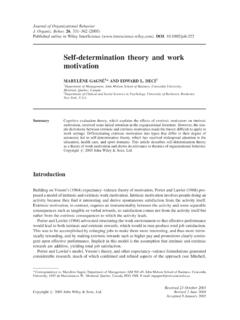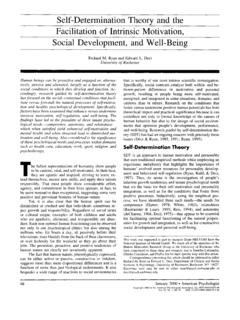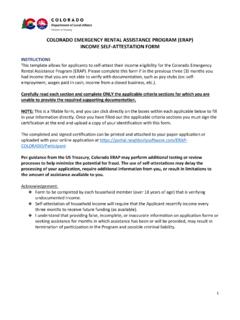Transcription of 1: Overview of Self-Determination Theory: Organismic ...
1 1: Overview of Self-Determination theory : An Organismic dialectical perspective Richard M. Ryan Edward L. Deci Unwersity o/ Rochestu In the classical, Aristotelian, view of human development, people arc assumed to possess an active tendency toward psychological growth and integration. Endowed with an innate stT h~ng to exercise and elaborate their interests, indi-viduals tt:nd naturally to seck challenges, to discover new perspectives, and 10 actively internalize and transform cultural practices. By stretching capaci-ties and expressing talents and propensities, people actualize their human potentials. Within this perspective , active growth is complemented by a tendency toward synthesis, organization, or relative unity of both knowledge and person-ality. Moreover, the integration of that which is experienced providt-s the basis for a coherent sense of self -a sense of wholeness, vitalit}\ and integrity.
2 To the degree that individuals have attained a sense of self , they can act in accord "~th, or be "true" to, that seU: This general view of an active, integrating organism with the potential to from a coherent sense of self can be found in psychodynamic and humanistic theories of personality and in cognitive theories of development. For example, psychoanalytic theorists posit inherent activity and a synthetic function of the ego (Freud, 1927; Nun berg, 1931; Meissner, 1981; White, 1963), and humani.~tic psy-clJOlogists postulate an actualizing tendency (Angyal, 1963; Maslow, 1955; Rogers, 1963). Similarly, many cognitive d<:vclopmcntal theories emphasize an organizational or imcgrativc tendency as an endogenous feature of the organism, proposing that development is clmracterized by an overarching organization function through which new self -extensions are brought into coherence with other cognitive stmctures (Piagct, 1971; 'vVerncr, 1948).
3 Preparation of this chapter was supported in part by a n:st~ gram from the National Institute of Mental Health (MH-53385). Copyrighted materia 4 HA '\l)BOOK OF ::TERMlKA'l'lOK lo Vat] ing degrees, some recent theories have continued 10 embrace s uch ao;sumptions ( ,, Ford, 1992; Locvinger & Blasi, 1991; Kuhl & Fuhrmann, 1998), recognizing the intrinsic propensities of people to engage active, curios-ity-based exploration and to integrate new experiences to the self . Oc~pite its lo ngevity and seeming popularity, the assumption of innate ten-dencies toward growth and integration is not without its critics. Among the more staundl oppom:nts of constructs concerning growth and integration have been operant be haviorists who assume there is no inherent direction to development and suggrs t that beha.,.;oral regulation and personality arc a function of rein-forcement histories and current contingencies ( , Skinner, 1953).
4 For them, any appearance of a n inner organization to personality is attributable not to a pre-sumed integrative tendent:y but rather ro the fact that the relevant contingencies people encountered in their environmems were organized and systematic. Similar!)\ contemporary social-cog nitive approaclu;s portray personality not in tcmts of a sell~unifying system, but rather as a collection of selves or that arc activated by cues. Personality is viewed as a repository for schemata related to various goals and identities, each of which can be elicited by features of the social contexts (Bandura, 1989; Higgin~, 198i; Markus & Nurius, 1986; Mischel & Shoda, 1995). Unlike their operant predecessors, s theories do not deny the idea of a synthetic tendency in d evelopment, but instead periphcralizc it, focusing on the uni1k'CI properties within isolated gnat schemata or regulatory structures rather than among such schemata or structures.
5 Finally, and perhaps most importantly, the concept of endogenous tcnden-cit"-~ toward psychological growth and unity in development seems to Oy in the face of everyday behavioral observations. Ambient e~;dence could readily sup-port the \~cw that people arc no more characterized by tendencies toward growth and integrity than by propensities to be controlled, fragmemcd, and stagnated in development. Everywhere, we S(:C signs of divided functioning, of inner conOict and a lack of concern \\~th responsibility and community. These widespread symptoms arc echoed psychological theories ( , Broughton, 1987; Greenwald, I 982). ln fact, Gergen ( I 993) ~;ewed tl1c metaphor of a core or true self that grows and struggles for unity as a post-romantic view that should be replaced by the acceptance of a postmodern perspective in which the self is more aptly described as fragmented, saturated, and diversely populated by identities that arc imputed by the social world.)
6 It s<,em.~ indeed that the field of psychology is quite widdy divided on the issues o f inherent tendencies toward psychologic-ill growth, a unified self ; and autonomous, responsible bcha\~Or. Whereas some theorists sec our nature as including a self -organizing, growth promoting tendency, others see us as wholly lacking such an endowment, and thus as mere conditioned or reactive reflections of our surroundings. importantly, each position seems to have some prima facie C\~dcncc in i~~ favor. This set of issu"s concerning the degree to which there are inherent tenden-cies toward growt11 and integration is important not only theoretically, but also Copyr ghlcd materia Overview of Se{f- determination Theor_y 5 practically. Insofar as practitioners believe people have a natural tendency toward ' ' ' d h 1 h 1 u gammg mtegnty an en ancmg t 1c1r uman potcnwus, t 1cy WI oncnt 10 sup-porting and facilitating that endogenous tendency across a variety of settings, including homes, schools, work organizations, and therapy clinics.}
7 In contrast, insofar as practitioners assume no such inner tendency toward growth, self -con-struction, and inner coherence, then , d1erapeutic, and other practi-cal intervention srrategies will focus on exogenous means of training, shaping, conrrolling, and directing behavior towards ends deemed to be of The Organismic Dialectic: An Integrating perspective The primary agenda of self -determinmjon th eo y (SOT; Occi & Ryan, 1985b; Ryan & Deci, 2000b) has been to provide an account of the seemingly discrepant viewpoints characterized, on the one hand, by the humanistk, psy-choanalytic, and developmental theories that employ an Organismic metatheory and, on the other hand, by the beha\~oral, cognitive, and post-modern theories that do not. Ln other words, recognizing that there is compelling evidence in favor of human tendencies toward active engagement and development and that there is, as wcU, manifold indication of fragmentation and conditioned responses, SOT provides a framework that imegratcs the phenomena illuminated by these dis-crepant viewpoints.
8 SOT begins by embracing th e assumption d1at all individuals have natural, innate, and constrU<:tivc tendencies to develop an ever more daborated and uni-fied sense of self . That is, we assume people have a primary propensity to forge interconnections among aspects of their own psyches as well as with other indi-viduals and groups in their social worlds. on terms used by Angyal ( 1963), we characterize this tendency toward integration as involving both auton-omy (tending toward inner organization and holistic self -regulation) and homon-omy (tending toward integration of oneself widt others). Healthy devclopmcm involves th e complementary functioning of these two aspects of the integrative tendency. H owever, although SOT accepts d1is general integrative tendency as a fim-damental aspect of human life, the theory also suggests that this tendent.')' cannot be taken for granted. On the contrary, SOT posits that there are clear and ;,vcci-fiablc social-contextual f.
9 'lctors that support this innate tendency, and that there are other specifiable factors that thwan or hinder this fundamental process of human nature. Accordingly, SOT predicts a broad array of developmental out-comes, ranging from a relatively active and integrated self to a highly fragment-ed and sometimes ;sive, reactive, or alienated sdf, as a function of social t!nvi-ronmcntal conditions. Copyrighted materia 6 HANDBOOK 01'" self ' DETERMl!l:i\TIOr\ Another way of stating this is that the foundations of SDT reside a dialec-tical view which concerns the interaction between an active, integntting human nature and social contexts th at either nurture or impede the organism's active nature. Social environments can, according to this perspective , either facilitate and enable the growth and integration propensities with which the human psy-dtc is endowed, or th(.-y can disntpt, fo=tall, and frngmcntthesc processes result-ing in behaviors and inner experiences that represent the darker side of human-ity.)
10 As such, psychological growth and integration in personality should neither be taken as a given, as something that will happen 'llly, nor should it be a~sumcd not to exist. Instead, it mus1 be as a dynamic potential that requires proximal and distal conditions of nurturance. ln this, we fully agree '>iUl Allport ( 1961) who suggested rhat unity in personality is a matter of degree and should not be exaggerated. We add, however, that whatever the attained unity of Ute psyche, the imporumce of Ute issue of integration wiutin personality cannot be over emphasized when one is attempting to understand the processes of hc.'lld1y psychological and social development. As , the issue is important for examining applied questions rclatt~d to cllcctive parenting, education, work, health care, C.'<er<:isc regimens, cn~iromneotalism, religiosity, psychotherapy, and other signific;mt human endeavors.





